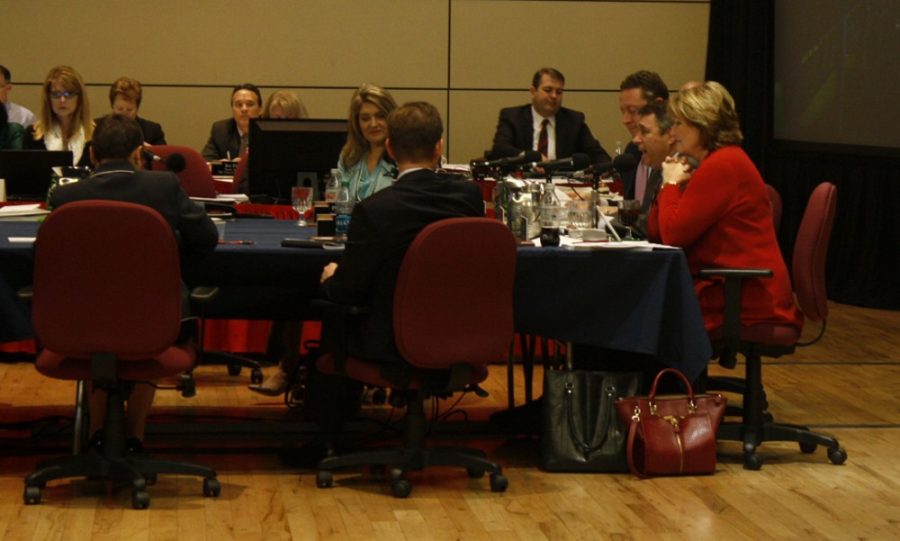TEMPE — Facing deep cuts from the state, Arizona university presidents formally presented their tuition proposals to the Arizona Board of Regents at a meeting Monday as it prepares to set rates for the next academic year.
The proposals, which call for increases in tuition and fees at the UA, Arizona State University and Northern Arizona University, drew discussion and scrutiny from the regents at the meeting on ASU’s Tempe campus. The board will vote to set the rates for Arizona students on May 4.
UA President Ann Weaver Hart called these increases necessary and a “very serious response” to cuts in funding from the state.
“This is the reality that we face,” she said. “We are committed to doing the right thing on tuition and serving our students.”
The state Legislature and Gov. Doug Ducey slashed $99 million in funding for higher education, which takes $53 million from ASU, $28.2 million from the UA and $17.2 million from NAU.
At the meeting, the regents continued their criticism of state leaders for the budget, which was signed by Ducey last month.
Board Chairman Mark Killian said he felt that “some in the Legislature are conducting a war on our public institutions.” He added that he is hearing rumors of further cuts to universities next year from the state.
“If that’s the case, we’re going to be right back here a year from now trying to figure out how to glue the place together and keep it going, and it’s not our fault,” Killian said. “It’s not the students’ fault. It’s a lack of recognition of what these institutions are doing.”
With these cuts, the total number of cuts to universities from the state since 2008 will total about $500 million, down from nearly $1.2 billion. The UA has nearly doubled its in-state tuition rate over the same period of time.
“I really resent being put in this position, because I felt the last couple of years we were making some progress,” Killian said.
The UA’s proposal calls for a 4.07 percent tuition increase for incoming in-state undergraduate students and a 10.9 percent hike for new out-of-state undergraduate students. For graduate students, the increases are 2.77 percent for in-state and 5.8 for out-of-state.
The guaranteed tuition program adopted last year ensures many current undergraduate students will not see their tuition increase. Under the proposal, current students who did not opt to the program will see smaller increases of 2.75 percent for in-state students and 5.8 percent for out-of-state students.
The UA’s proposal also includes an additional 19 program fees and 20 class fees for students. This would bring the total to 96 program fees and 1,310 class fees for the university. The new program fees would generate an additional $2.9 million for the UA.
Mandatory fees would also be brought under the guaranteed tuition program, as well as some masters programs at the UA.
Hart said the proposal does not totally shift the burden on to students as she said the university will make cuts to its own budget.
“This is not simply a matter of adding revenue,” she said.
Student Regent Valerie Hanna said UA leadership did consider student leaders’ input throughout the months-long tuition-setting process.
The regents also debated the rising number of fees being charged to students at state universities. The number of program fees at the UA has nearly tripled since 2007, but the number of class fees has decreased by about 300 in the past five years.
Killian said the increasing fees at the UA, ASU and NAU, which coincided with decreases in state funding, show the blame lies at the feet of the Legislature. He suggested that, in an effort to highlight how much state cuts are costing students, the regents should roll all the fees into the price of tuition that everyone would pay.
Killian has recently called for the board of regents to sue the Legislature for violating the part of the Arizona constitution that states a college education should be as close to free as possible.
Regent Rick Myers defended the fees as a more transparent way for students to know that money is going to a specific purpose.
“There actually is a lot of accountability as well as visibility that comes with the way we’re putting fees in place,” he said. “Students this year were very supportive of the process the universities went through because they knew exactly how the money would be spent.”
ASU proposed a temporary $320 fee to cover the sharp cuts from the state for its in-state students. Some regents said they liked the idea of the surcharge, but Hart later said she didn’t believe that would be right for the UA.
Hart said, based on comments from Ducey at a meeting earlier this month, there is no reason to believe state funding for the universities will be restored any time soon.









